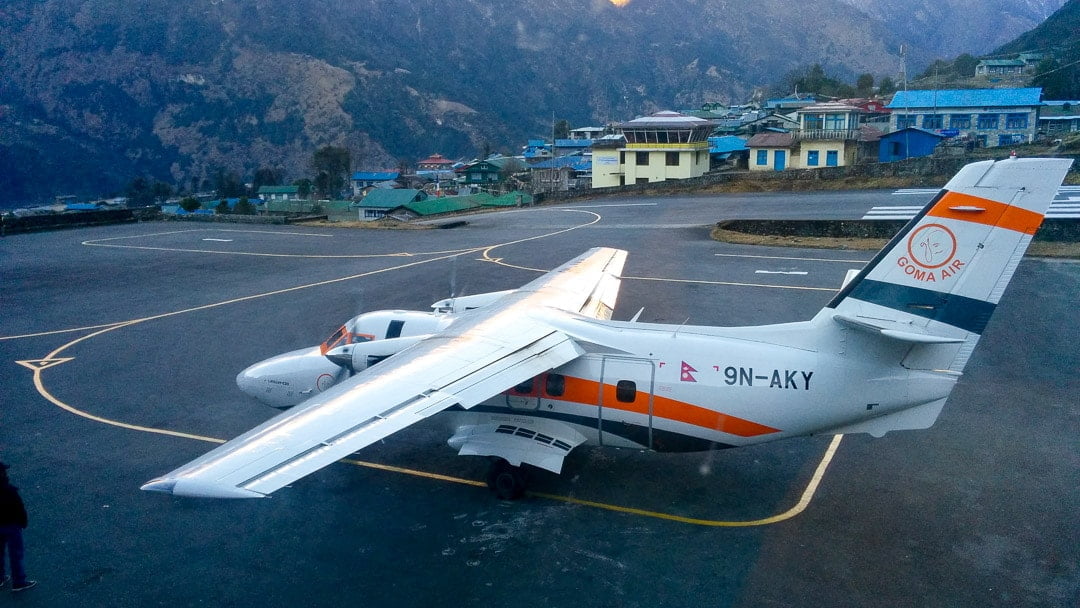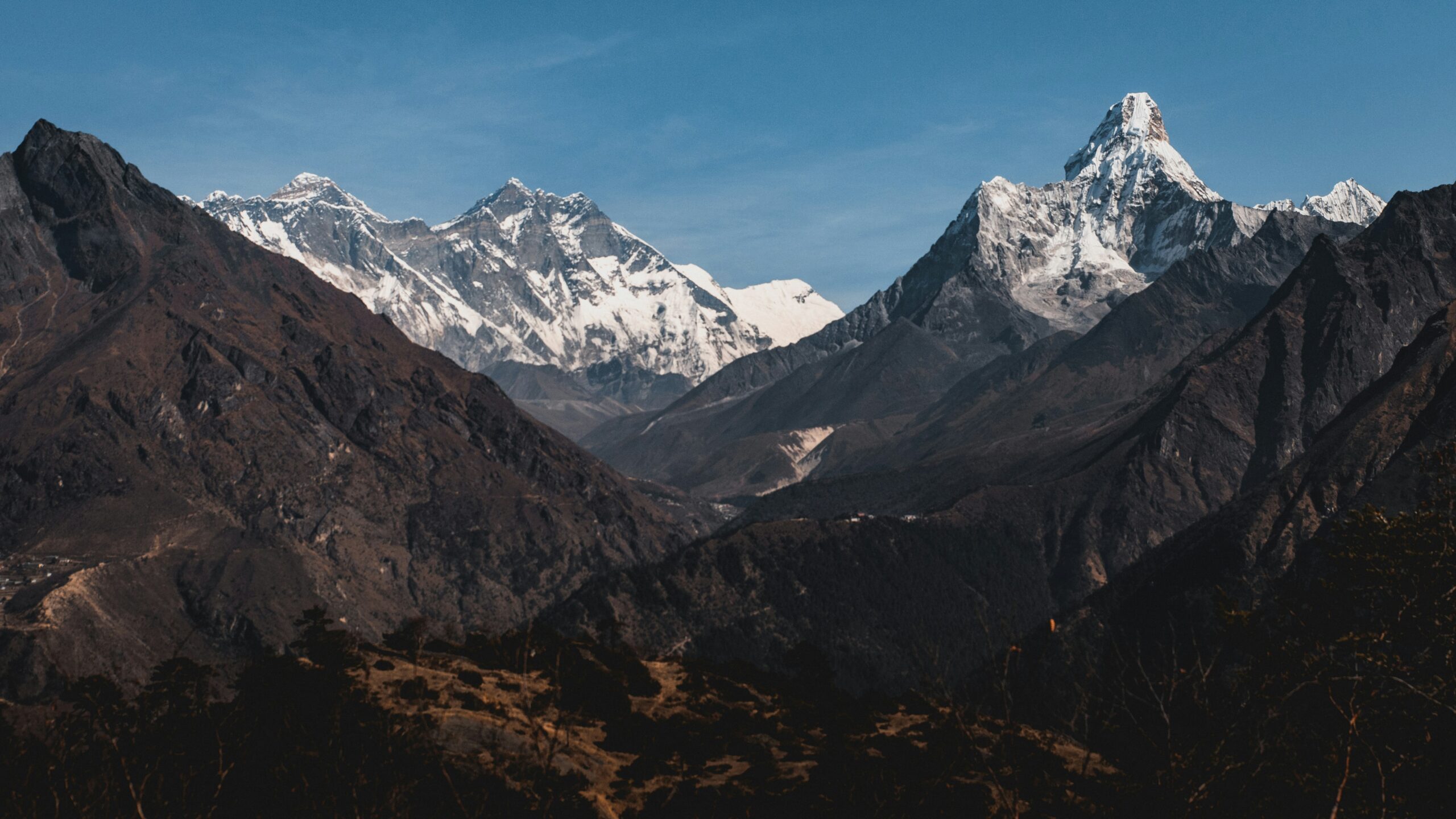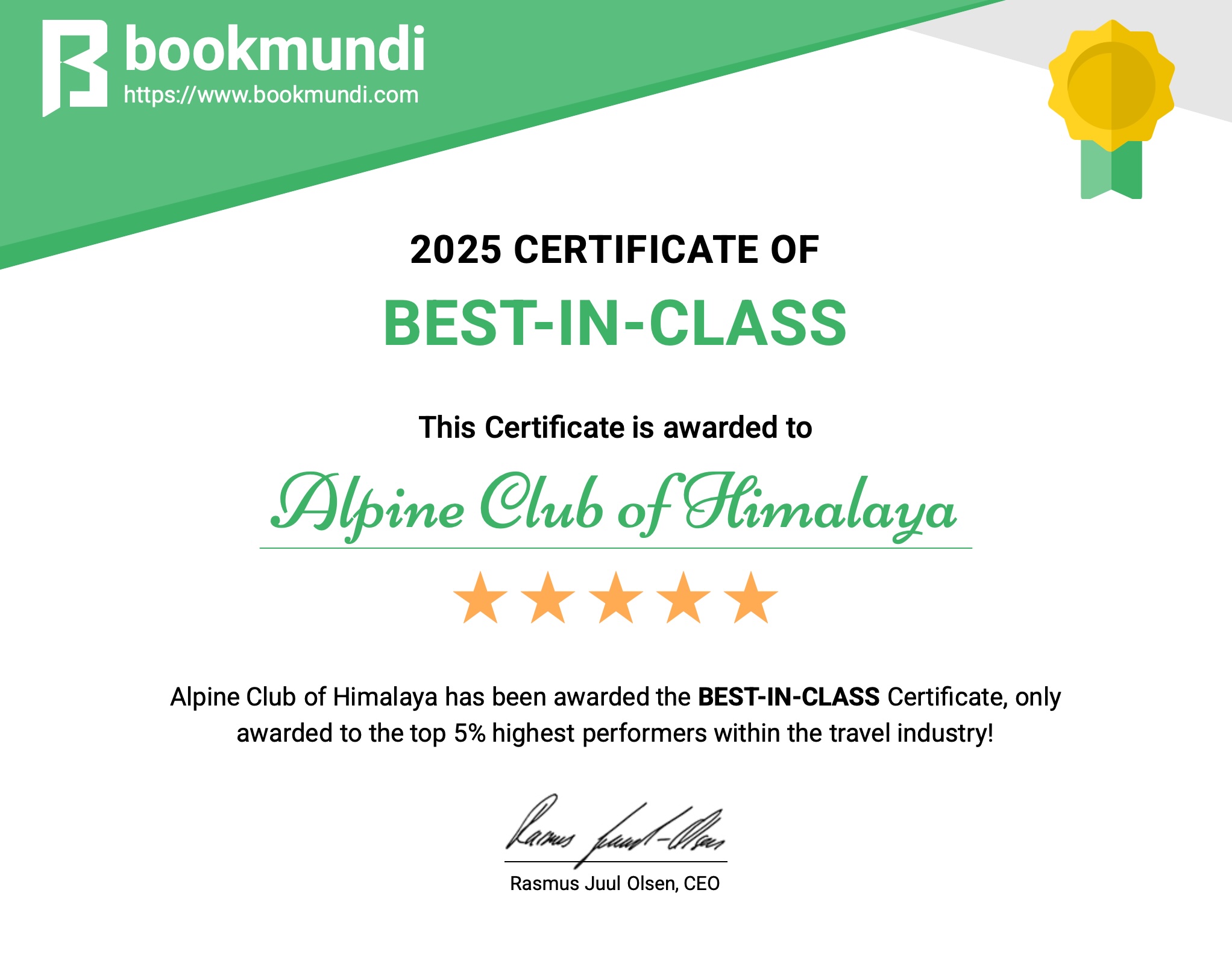Tilicho Lake And Thorong-La Pass Trek, a unique way to experience the incredible wonders of the Annapurna Region. Tilicho Lake is one of the most popular destinations of the Annapurna Circuit trek. The Lake nested at 4920 meters collecting the glacial waters of the entire northern slopes of Annapurna and Thorong Peak. One of the extensive glacier systems of the great barrier. The glaciers terminate in a vertical wall of ice 70 meters high that forms the west shore of the lake. Snowbound by a ridge between Khangsar Kang (7485m) and Nilgiri North (7061m). The next attraction is Thorong La Pass. A high mountain pass with an elevation of 5,416 meters (17,769 ft) in the laps of Damodar Himal, north of the Annapurna Himal. The highest point of your trek.
Tilicho Lake And Thorong-La Pass Trek takes you across village inhabited by a wide diversity of people, lush agricultural fields and apple orchards, the deep wilderness of sub-tropical and alpine forests, high mountain meadows, cliffs and ridges, river networks, lakes, and high mountain pass on the foothills of the Himalayas. On this trek experience the wonders of the region and compliment it with the people you meet.
Overview:
The Tilicho Lake And Thorong-La Pass Trek starts with a long drive from Kathmandu to Besisahar. Besisahar has long been the starting point of various treks of the Annapurna Circuit. From Besisahar trekking across terraces farms with grand views of Himalchuli and Manaslu dominating the horizon reache village of Bahundanda. Next trekking along banks of the mighty Marsyangdi River following a series of steep stone paved stairs head towards Chamje. Then move on towards Bagarchhap, following the deep wilderness of bamboo, rhododendron, blue pine, spruce, hemlock, maple, and oak.
From Bagarchhap, traversing through the lush woodlands of Pines and Fir enter the beautiful Manang Valley and to the settlement of Chame. Next following the trails of steep narrow valley head to Upper Pisang. Along the way witness the Paungda Danda rock face, a dramatic curved rock face rising 1500-meter from the river. Along with Annapurna II to the south and Pisang Peak to the northeast.
Tilicho Base Camp
Then traversing across with the scenic views of high alpine landscapes and an endless range of mountains in the background head towards the bustling settlement of Manang. Situated in the broad valley of the Marsyangdi River. After an acclimatization day exploring wonders of Manang proceed to Khangsar village nestled on the banks of the Khangsar River. Then move on following screed slopes to a side valley towards the Tilicho Base Camp.
Following cliffs with sheer drops and moraine that cuts along the side of the mountain head towards Tilicho Lake. Along this section witness grand views of the mountain giants of Tilicho, Nilgiri, Khangsar, Muktinath peaks, and other endless peaks. At Tilicho soak in the energy and relax on the brown banks of the turquoise waters. The following day traversing across alpine vegetation and green meadows reach Yak Kharka a high alpine pastureland of the region. Then following the trails of high alpine grassland with patches of shrubs and dwarf junipers. Along the mountain giants of Gundang, Syagang, Thorung, and Khatungkan reach Thorung Phedi. The last village perched on the foothills of the high Thorong La pass.
Thorong La
The next day cross the high mountain pass of Thorong La at an elevation of 5416 meters. The highest point of your trek. From the top of the pass witness, grand views of the Annapurna, Mukut, and Mustang ranges with the Kali Gandaki valley seen far below. Following the downhill, path reach the ancient settlement of Muktinath.
Muktinath is one of Nepal’s most sacred pilgrimage sites for both Hindus and Buddhists. Muktinath means the place of Nirvana and is home to the Muktinath temple. Here visit the ancient temple and witness grand views of the landscape, the green apple orchards, and snow-white peaks on the backdrops of brown, grey hills. Next head towards Jomsom following the river down south, through the wide, windswept, and barren valley. Jomsom is an important settlement of the region and provides basic to grandeur amenities. The following day catch a picturous flight to Pokhara. At Pokhara explore the attractions around and eventually head back to Kathmandu which marks the end of the Tilicho Lake And Thorong-La Pass Trek.
Head on this unique way to experience the incredible wonders of the Annapurna Region with the Alpine Club of Himalaya.
Entry and Permits:
The following permits are required for trekking to Tlicho Lake and Thorong-La Pass Trek:
- Upper Mustang Restricted Area Permit for all foreigners: US $500 per person for the first 10 days and US $50 per person per day thereafter.
- ACAP entry permit fee for foreigners: 3,000 NPR (Approx. US $30)
- ACAP entry permit fee for SAARC nationals: 200 NPR
TIMS Permit :
- NRP 1,000 per person for organized treks through an agency
- NRP 2,000 per person for independent trekkers (going without a guide or porter)
Note: All the trekking permits are handled by the Alpine Club of Himalaya.
Meals and drinking water:
Along the Annapurna Region Trek, you will be provided with various Nepali, and Tibetan ethnic cuisines, and varieties of continental as well as western meals. The region has several tea-house along the trail and is run by local inhabitants providing basic and minimal facilities to luxury ones. You will have an opportunity to taste various cuisines which you will miss it most of trekking trails of Nepal.
Annapurna Region is a plastic-free zone and has banned the use of bottled Mineral Water. However, drinking water taps are accessible with natural water supplies all along the trekking trail which are untreated, so direct use of the water is not recommended, you may refill boiling water or cold filter water from any of the teahouses along the trail.
If you buy a water purification tablet, chlorine drops or utilize SODIS (sunlight assisted) filtration procedures for further assurance, saving money, and reducing plastic pollution.
Accommodation:
Tourist-friendly hotels, lodges, and local accommodations are available on trekking trails and, providing with basic accommodation to luxury and grandeur ones. Luxury hotels and teahouse are situated along the trail that suits your budgets providing comfortable beds with a pillow, electric blankets, hot and cold shower, free WIFI, and many more.
Teahouse along Annapurna region provides you with hot shower, western attached bathrooms and the rooms mostly include twin sharing beds as well as a single bed, with hygienic and clean atmosphere, good mattresses, a pillow, and blankets.
Campsites are also available along the trail providing a special opportunity for campers to sleep under the stars.
Best Time to Visit?
The best season for trekking in Annapurna Region is during autumn and spring.
The months of September, October, November, March, April, and May are the best time to visit. These months are better in terms of visibility and climate conditions.
Autumn season, the months of September, October, and November are one of the best times for trekking in this region. As the weather is clear bringing great visibility of the endless mountain ranges and lush green forest with warm temperatures, the nights are clear and is a perfect opportunity for stargazing.
The spring season of March, April, and May is also the best time to visit the Annapurna Region. The end of the winter season brings a change in the region, varieties of colorful blooming trees of the sub-alpine forest, high green pasture lands covered with wildflowers, mild temperatures, and clear weather. In this season you will witness herds of sheep and yaks grazing in the green high lands.
Monsoon season is not favorable as the weather gets harsh and it’s hard to get around the country, with frequent rainstorms and landslides. So, monsoon season is mostly avoided by trekkers.
Annapurna Region receives high snowfall covering most of trails and making it impossible to travel for this reason in winter.
Travel Insurance:
All clients participating in any activity must have travel insurance. Personal injury, death, hospital expenditures, repatriation fees, helicopter rescue, and any other disease covered by the insurance plan will be given, we highly advise you to acquire a comprehensive insurance plan from a trustworthy insurance company.
Passport and Visa:
Every client must have a valid passport from the return date with a 6 months prior validity by the Nepalese consulate in your country or immigration office at Tribhuvan International Airport in Kathmandu.
Important Note:
Your safety is of paramount importance to us at the Alpine Club of Himalaya. We have the absolute authority to cancel the itinerary, when we have reason to believe your safety is at stake. Weather conditions, the health condition of a group member, natural disasters, and such, can contribute to changes in the itinerary when traveling in remote mountainous regions. In these extreme situations, we kindly request that you offer your full co-operation to the trusted leader of the group appointed by the Alpine Club of Himalaya. However, we assure you that we will make every effort to keep to the above itinerary.
Overview
Important Note
Your safety is of paramount importance to us at Alpine Club of Himalaya. We have the absolute authority to cancel the trip or change the itinerary, when deemed necessary or when we have reason to believe your safety is at stake. Weather conditions, the health condition of a group member, natural disasters, and such, can contribute to changes in the itinerary when traveling in remote mountainous regions. In these extreme situations, we kindly request that you offer your full co-operation to the trusted leader of the group appointed by the Alpine Club of Himalaya. However, we assure you that we will make every effort to keep to the above itinerary.
Trip Highlight
- Tilicho Lake
- Panoramic Views
- Mountain Range
- Local People
- Local Food

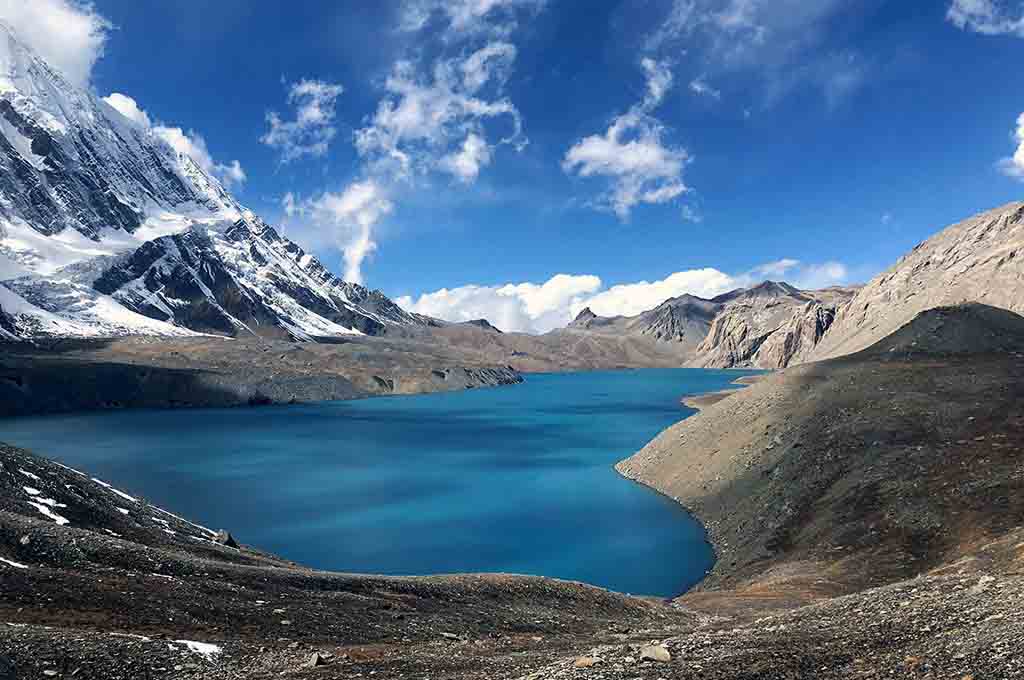

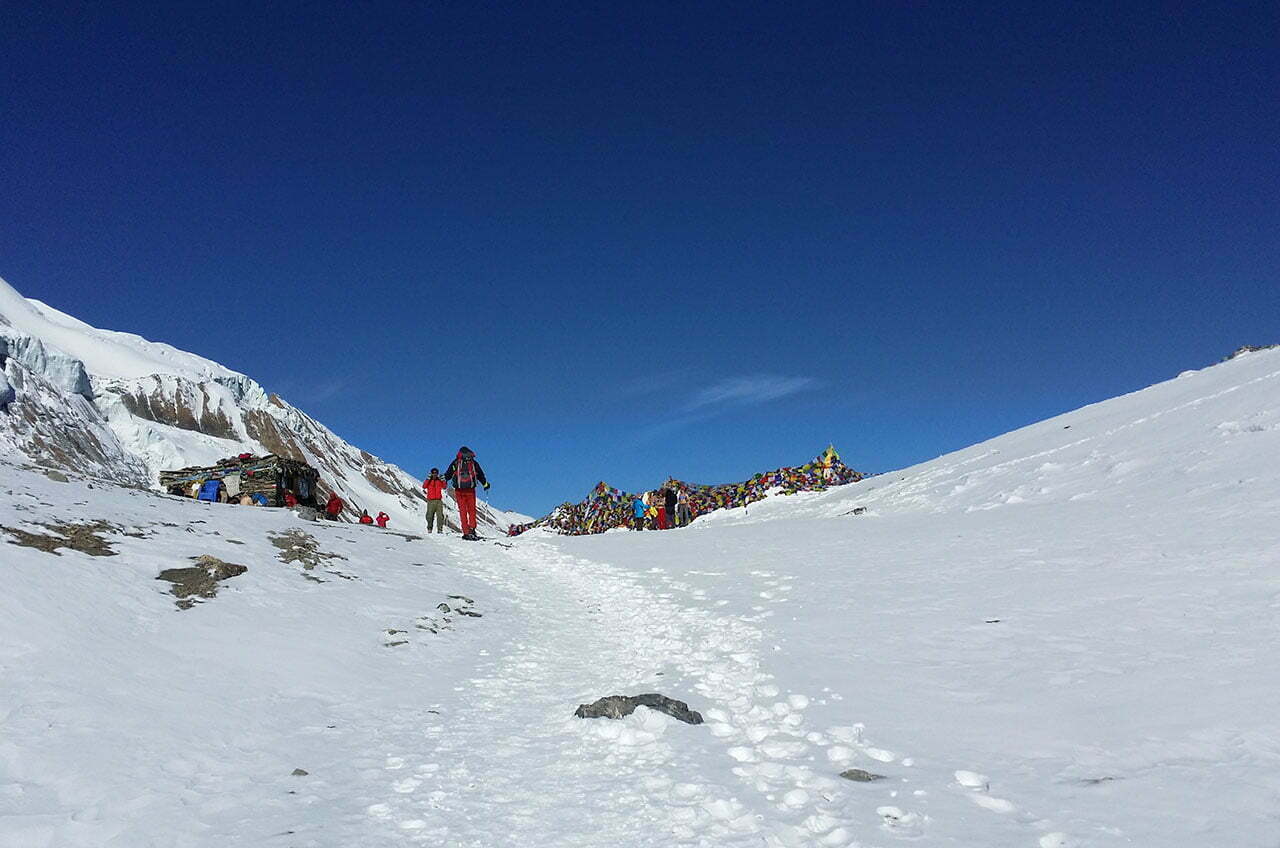
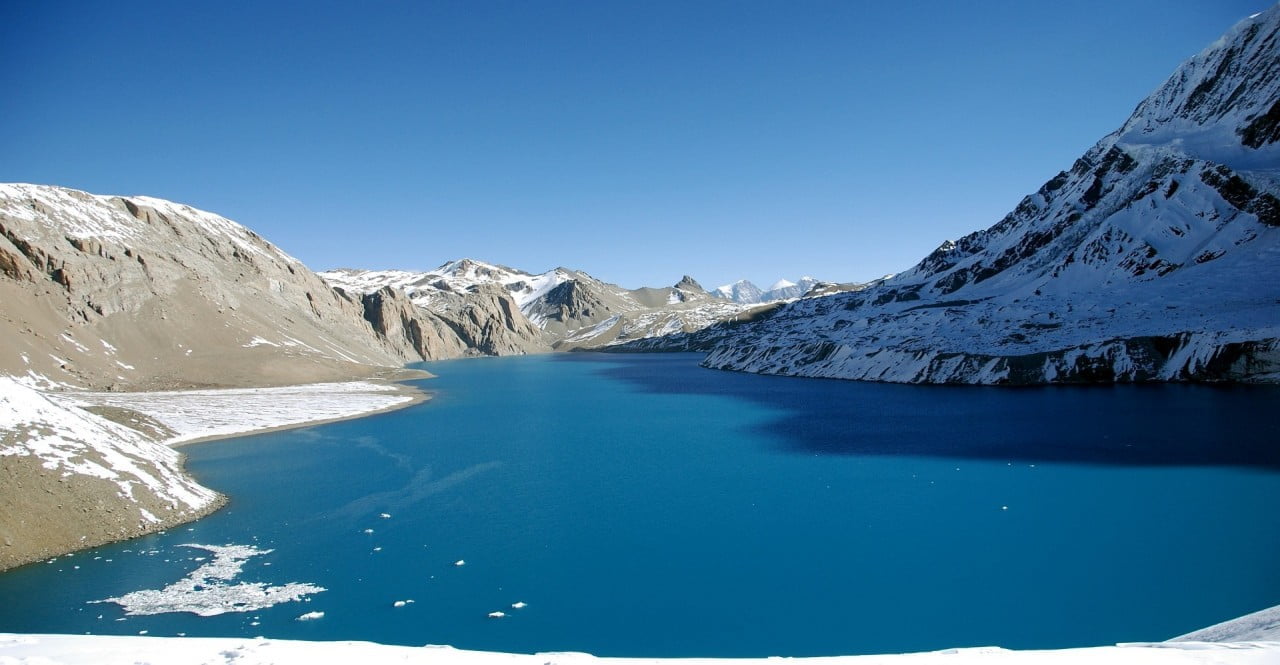

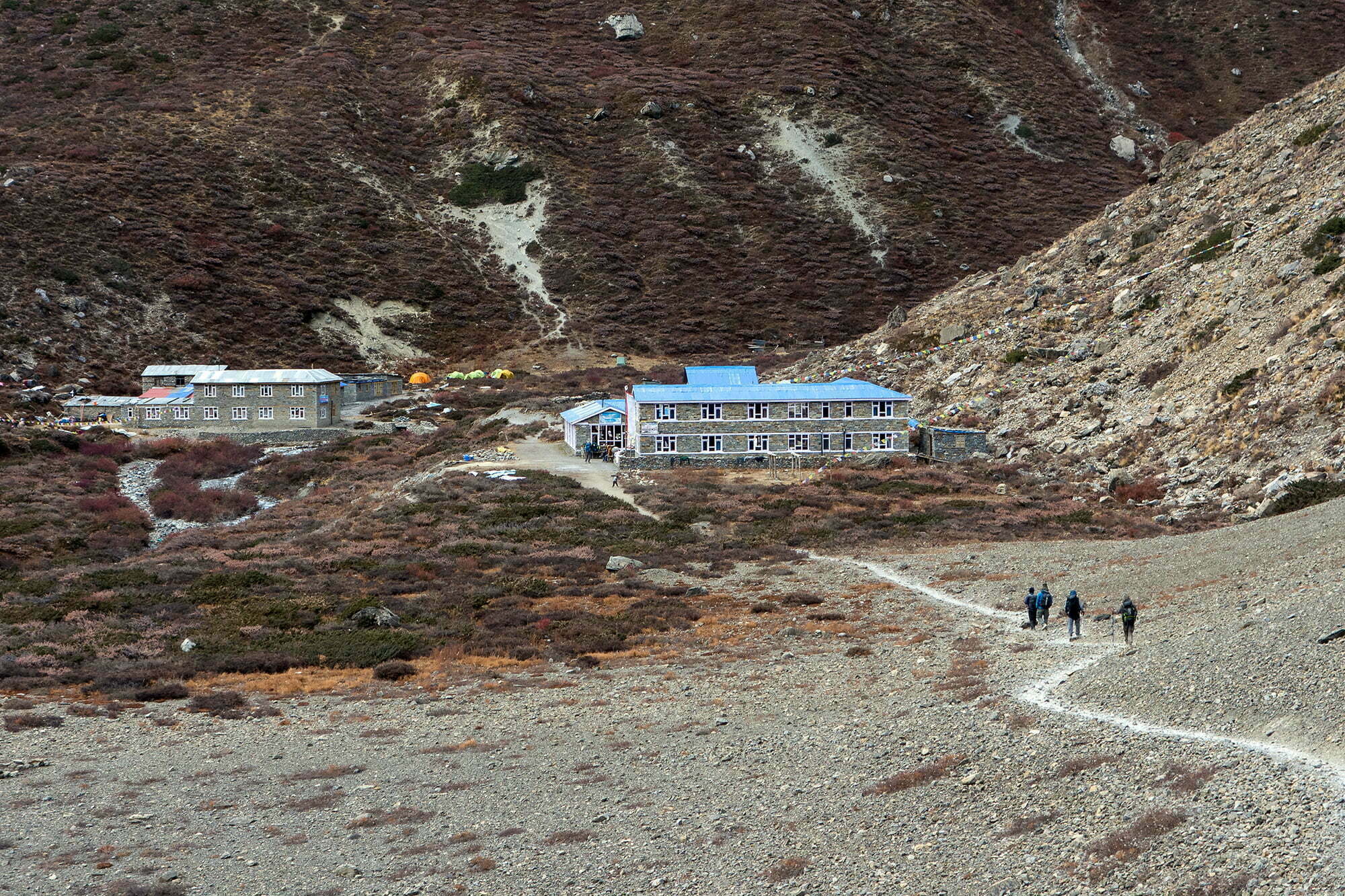
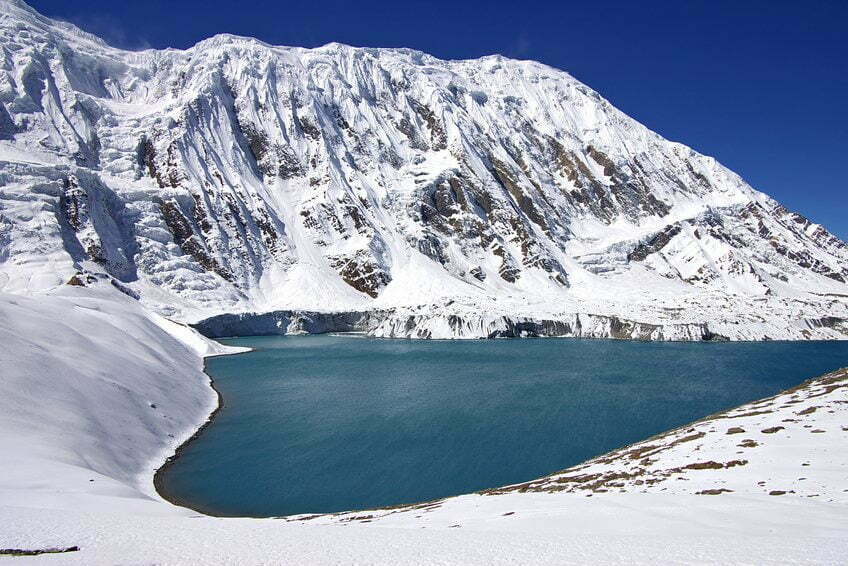

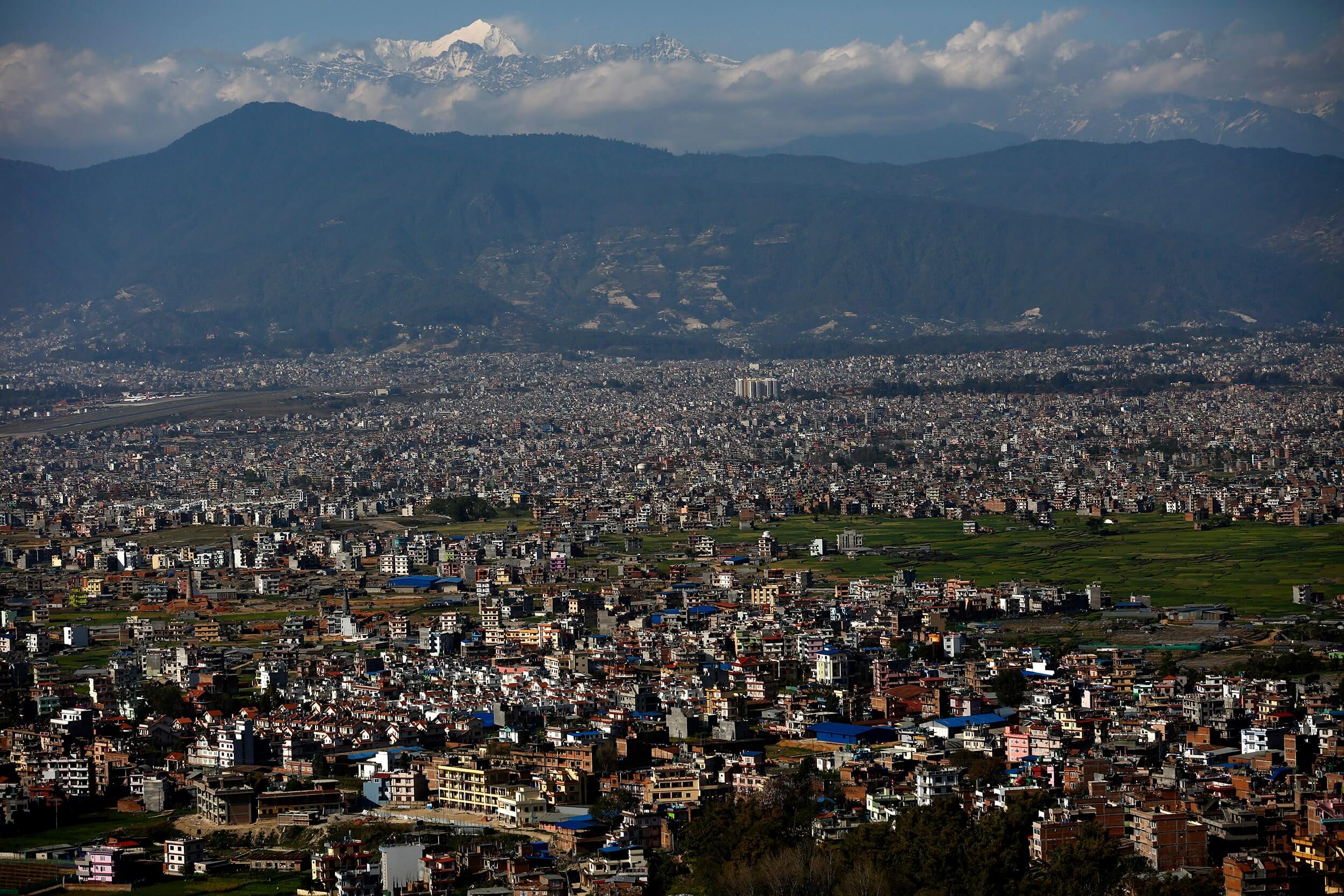 Kathmandu Valley
Upon arrival at the Kathmandu, Tribhuvan International Airport. A representative from the Alpine Club of Himalaya will assist you with your accommodation. Upon arriving at your hotel, rest for a while. In the evening join in for a special dinner program where you will experience excellent Nepalese cuisine.
Maximum Altitude: 1400m
Meals: Welcome Dinner
Accommodation: Hotel
Kathmandu Valley
Upon arrival at the Kathmandu, Tribhuvan International Airport. A representative from the Alpine Club of Himalaya will assist you with your accommodation. Upon arriving at your hotel, rest for a while. In the evening join in for a special dinner program where you will experience excellent Nepalese cuisine.
Maximum Altitude: 1400m
Meals: Welcome Dinner
Accommodation: Hotel 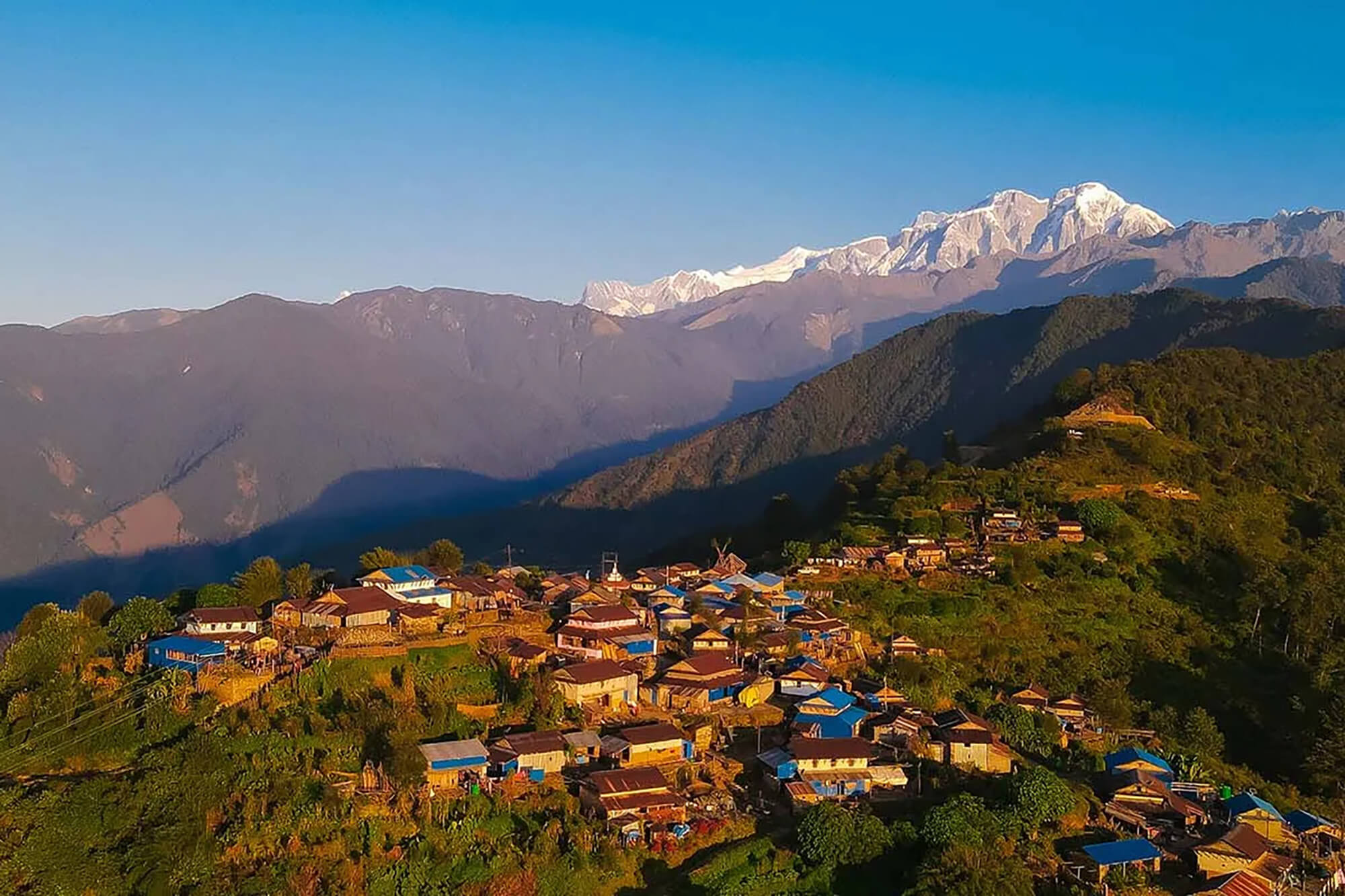 Besi Sahar
After breakfast head on a long drive towards Besi Sahar along the Kathmandu-Pokhara highway. Besi Sahar is the headquarters of Lamjung and has long been the starting point for the Annapurna circuit trek. Upon reaching Besi Sahar explore the bustling settlement.
Maximum Altitude: 760m
Duration: 6 hours drive
Meals: Breakfast, Lunch, and Dinner
Accommodation: Guesthouse
Besi Sahar
After breakfast head on a long drive towards Besi Sahar along the Kathmandu-Pokhara highway. Besi Sahar is the headquarters of Lamjung and has long been the starting point for the Annapurna circuit trek. Upon reaching Besi Sahar explore the bustling settlement.
Maximum Altitude: 760m
Duration: 6 hours drive
Meals: Breakfast, Lunch, and Dinner
Accommodation: Guesthouse  Bahundanda
Following the dirt road at the northern end of the Besi Sahar start your trek. As you progress proceed on a rough rock staircase down to the Puwa Khola and join the road to Khudi at an elevation of 830 meters, the first Gurung village on the trek.
Next, cross the suspension bridge and rejoin the road on the other side of Khudi and continue to Bhulbule at 840 meters. Along this section witness, the grand views of Himalchuli and Manaslu dominate the horizon. Now leaving the road cross a suspension bridge over Marsyangdi Khola from where the trail travels up past an impressive 60-meter waterfall surrounded by tropical trees. As you progress the trail takes you across terraces and farms with views of Manaslu and Ngadi Chuli to the tiny settlement of Ngadi at 900 meters.
Crossing Sisneri Khola reaches a Tibetan settlement and porters stop. Traversing across hills and chasing river networks, reach a hot water spring in the region. A steep ascends through bamboo grooves, and you will finally reach Bahundanda.
Maximum Altitude: 1270m
Duration: 5-6 hours
Meals: Breakfast, Lunch, and Dinner
Accommodation: Guesthouse
Bahundanda
Following the dirt road at the northern end of the Besi Sahar start your trek. As you progress proceed on a rough rock staircase down to the Puwa Khola and join the road to Khudi at an elevation of 830 meters, the first Gurung village on the trek.
Next, cross the suspension bridge and rejoin the road on the other side of Khudi and continue to Bhulbule at 840 meters. Along this section witness, the grand views of Himalchuli and Manaslu dominate the horizon. Now leaving the road cross a suspension bridge over Marsyangdi Khola from where the trail travels up past an impressive 60-meter waterfall surrounded by tropical trees. As you progress the trail takes you across terraces and farms with views of Manaslu and Ngadi Chuli to the tiny settlement of Ngadi at 900 meters.
Crossing Sisneri Khola reaches a Tibetan settlement and porters stop. Traversing across hills and chasing river networks, reach a hot water spring in the region. A steep ascends through bamboo grooves, and you will finally reach Bahundanda.
Maximum Altitude: 1270m
Duration: 5-6 hours
Meals: Breakfast, Lunch, and Dinner
Accommodation: Guesthouse 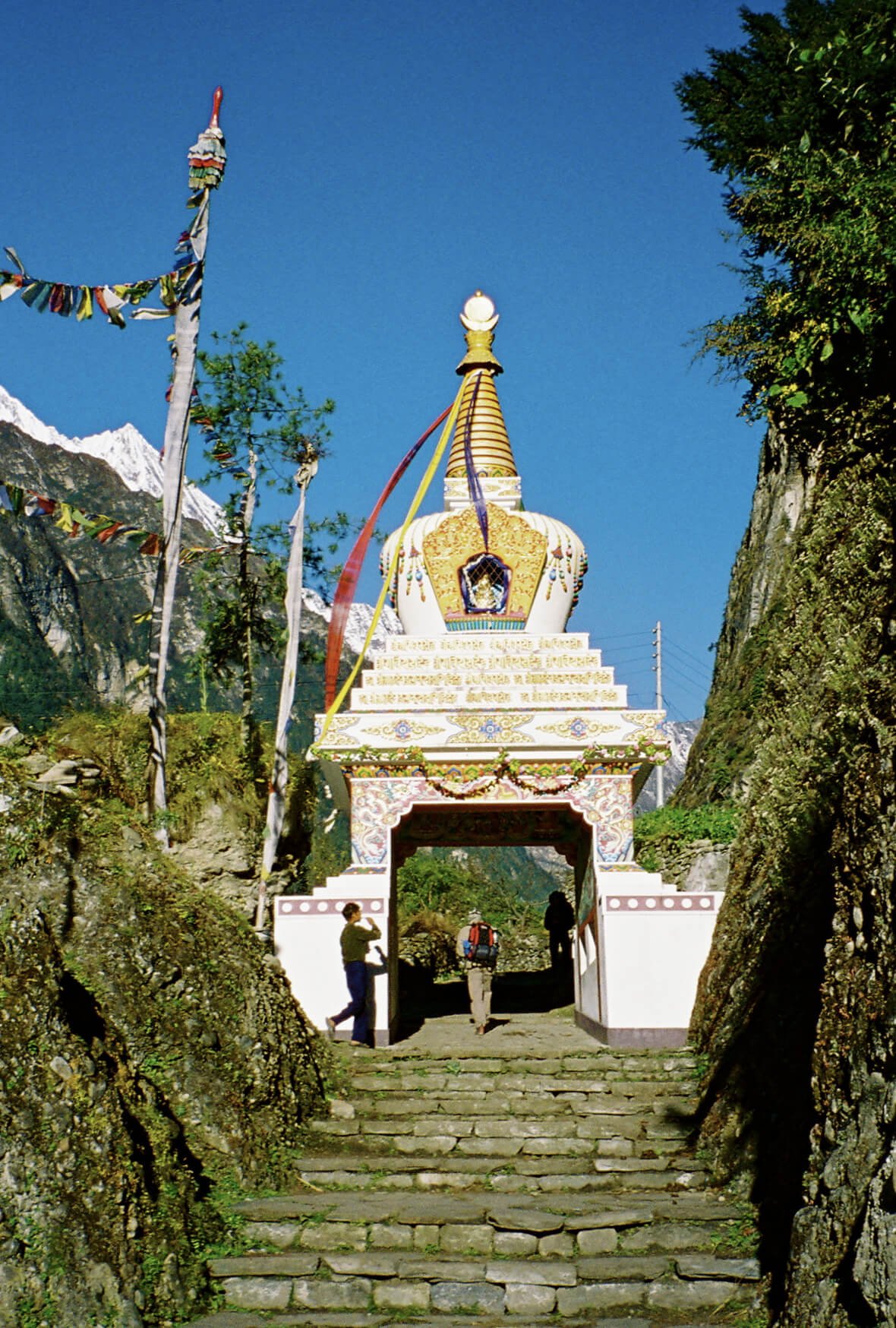 Chame
Today you will be entering the beautiful Manang Valley. Following the ascending route with might views of the Himalayan peaks start your trek. As you progress you will be traversing through lush woodlands of Pines and Fir and reach the settlement of Danaque also known as Syal Khola at an elevation of 2210 meters. From here head on a steep climb crisscrossing through rhododendron forest to reach the scruffy settlement of Timang at 2630 meters.
From Timang climbing through deep canopy cross villages of Thanchowk and Koto and eventually reach the large village of Chame.
Maximum Altitude: 2710m
Duration: 5-6 hours
Meals: Breakfast, Lunch, and Dinner
Accommodation: Guesthouse
Chame
Today you will be entering the beautiful Manang Valley. Following the ascending route with might views of the Himalayan peaks start your trek. As you progress you will be traversing through lush woodlands of Pines and Fir and reach the settlement of Danaque also known as Syal Khola at an elevation of 2210 meters. From here head on a steep climb crisscrossing through rhododendron forest to reach the scruffy settlement of Timang at 2630 meters.
From Timang climbing through deep canopy cross villages of Thanchowk and Koto and eventually reach the large village of Chame.
Maximum Altitude: 2710m
Duration: 5-6 hours
Meals: Breakfast, Lunch, and Dinner
Accommodation: Guesthouse  Upper Pisang
Traversing on an ascending and descending route along the hill section follow the trail. As you progress you will be following the trails leading through a steep narrow valley. From here catch your first view of Paungda Danda rock face, a dramatic curved rock face rising 1500-meter from the river along with Annapurna II to the south and Pisang Peak to the northeast. Passing various sparsely populated settlements descend towards Manang valley. A brief walk and you will reach the village of Pisang. From Pisang, a steep ascent and you will eventually reach the village of Upper Pisang.
Maximum Altitude: 3310m
Duration: 4-5 hours
Meals: Breakfast, Lunch, and Dinner
Accommodation: Guesthouse
Upper Pisang
Traversing on an ascending and descending route along the hill section follow the trail. As you progress you will be following the trails leading through a steep narrow valley. From here catch your first view of Paungda Danda rock face, a dramatic curved rock face rising 1500-meter from the river along with Annapurna II to the south and Pisang Peak to the northeast. Passing various sparsely populated settlements descend towards Manang valley. A brief walk and you will reach the village of Pisang. From Pisang, a steep ascent and you will eventually reach the village of Upper Pisang.
Maximum Altitude: 3310m
Duration: 4-5 hours
Meals: Breakfast, Lunch, and Dinner
Accommodation: Guesthouse 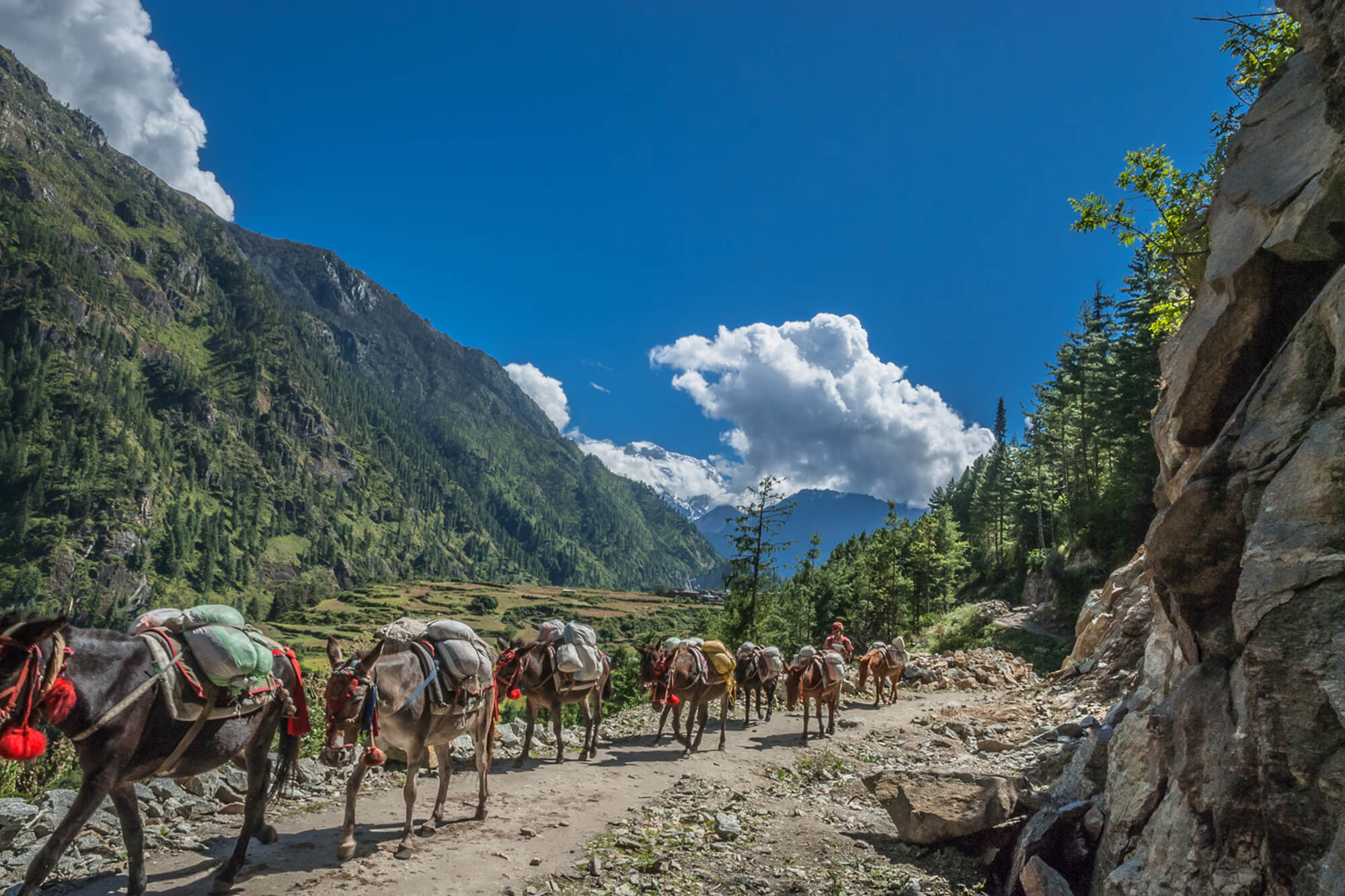 Manang
Today continue through the drier upper part of the Manang district, cut off from the full effect of the monsoon by the Annapurna Range. People of this region herd the yaks & raise crops for part of the year.
You will have two options for the trek, a high route to Manang via the villages of Gyaru and Ngawal which takes around 8 to 9 hours, or a shorter main trail to Manang which goes through a low pass into the valley below Pisang peak and takes around 5 to 6 hours. Ask your guide for advice, both trail has scenic views of high alpine landscapes with an endless range of mountain in the background. Along the trail visit the Barge Monastery, the biggest monastery in the Manang District.
Maximum Altitude: 3540m
Duration: 5 hours
Meals: Breakfast, Lunch, and Dinner
Accommodation: Guesthouse
Manang
Today continue through the drier upper part of the Manang district, cut off from the full effect of the monsoon by the Annapurna Range. People of this region herd the yaks & raise crops for part of the year.
You will have two options for the trek, a high route to Manang via the villages of Gyaru and Ngawal which takes around 8 to 9 hours, or a shorter main trail to Manang which goes through a low pass into the valley below Pisang peak and takes around 5 to 6 hours. Ask your guide for advice, both trail has scenic views of high alpine landscapes with an endless range of mountain in the background. Along the trail visit the Barge Monastery, the biggest monastery in the Manang District.
Maximum Altitude: 3540m
Duration: 5 hours
Meals: Breakfast, Lunch, and Dinner
Accommodation: Guesthouse 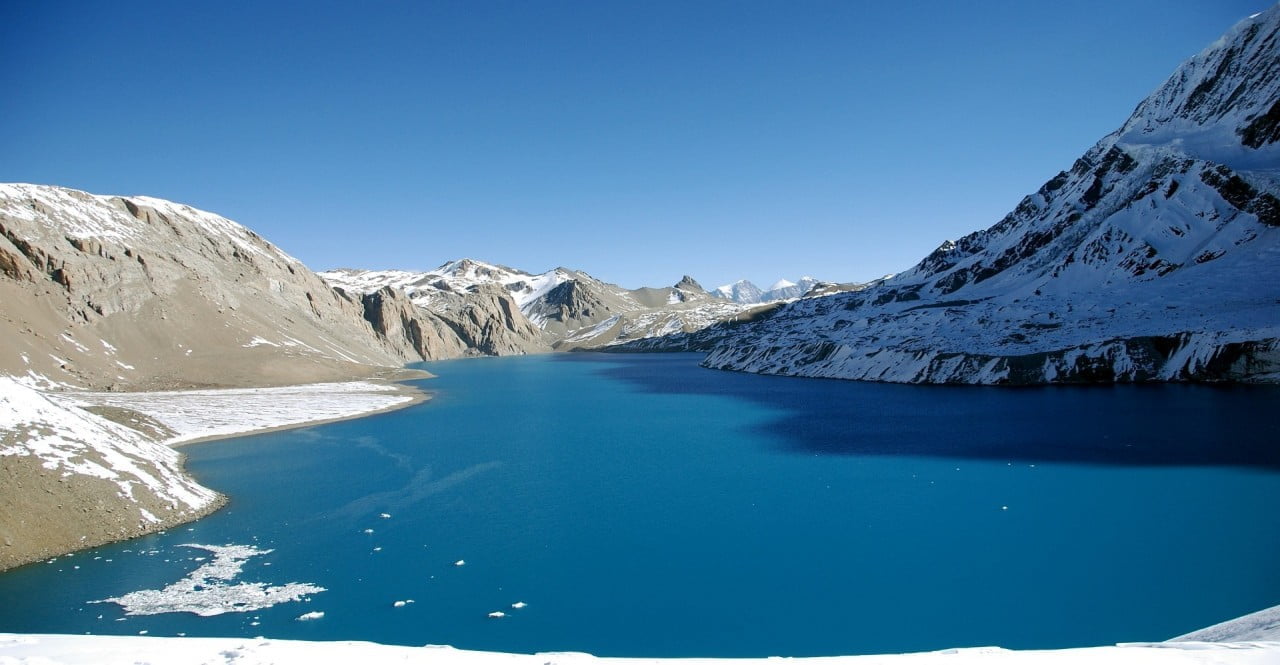 Tilicho Lake
Today start early as the weather can deteriorate quickly at higher altitudes. Start by following a tough ascent. Next, the trail traverses onto a moraine and then cuts along the side of the mountain. Witness the splendid views of Tilicho, Nilgiri, Khangsar, Muktinath peaks, and other peaks all around. A strenuous climb will take you to Tilicho Lake.
Upon reaching, one of the highest lakes in the world, you will get to admire its tranquil beauty. Sometimes reflections of the surrounding peaks are seen on its turquoise waters, at other times the lake remains frozen. Take a break beside the calm waters and soak in the astounding views before heading back to the base camp.
Maximum Altitude: 4920m
Duration: 6-7 hours
Meals: Breakfast, Lunch, and Dinner
Accommodation: Guesthouse
Tilicho Lake
Today start early as the weather can deteriorate quickly at higher altitudes. Start by following a tough ascent. Next, the trail traverses onto a moraine and then cuts along the side of the mountain. Witness the splendid views of Tilicho, Nilgiri, Khangsar, Muktinath peaks, and other peaks all around. A strenuous climb will take you to Tilicho Lake.
Upon reaching, one of the highest lakes in the world, you will get to admire its tranquil beauty. Sometimes reflections of the surrounding peaks are seen on its turquoise waters, at other times the lake remains frozen. Take a break beside the calm waters and soak in the astounding views before heading back to the base camp.
Maximum Altitude: 4920m
Duration: 6-7 hours
Meals: Breakfast, Lunch, and Dinner
Accommodation: Guesthouse  After breakfast head towards Yak Kharka. The trail leads out of the Marsyangdi valley and the abrupt change in surroundings can be noticed as the tree line disappears and is replaced with more alpine vegetation. The trek continues through the ruins of the old Khangsar village until you cross a log bridge over the river between Gumsang and Yak Kharka. The typical Himalayan village of Yak Kharka is an accolade to its name, where you can see yaks grazing around with Annapurna III on the backdrop. High alpine pastureland for Yaks. Upon reaching the village relax on the green meadows soaking in the energy of the region.
Maximum Altitude: 4020m
Duration: 5 hours
Meals: Breakfast, Lunch, and Dinner
Accommodation: Guesthouse
After breakfast head towards Yak Kharka. The trail leads out of the Marsyangdi valley and the abrupt change in surroundings can be noticed as the tree line disappears and is replaced with more alpine vegetation. The trek continues through the ruins of the old Khangsar village until you cross a log bridge over the river between Gumsang and Yak Kharka. The typical Himalayan village of Yak Kharka is an accolade to its name, where you can see yaks grazing around with Annapurna III on the backdrop. High alpine pastureland for Yaks. Upon reaching the village relax on the green meadows soaking in the energy of the region.
Maximum Altitude: 4020m
Duration: 5 hours
Meals: Breakfast, Lunch, and Dinner
Accommodation: Guesthouse  Thorung Phedi
Traverse across high alpine grassland with patches of shrubs and dwarf junipers. A brief uphill stretch and you will cross a suspension bridge which brings you to the village of Ledar. From here ascend further on small grey and brown hilltops along the towering cliffs of Mount Gundang, Mount Syagang, Thorung Peak, and Mount Khatungkan you will eventually reach Thorung Phedi, the last village perched on the foothills of the high Thorong La pass.
Maximum Altitude: 4540m
Duration: 3-4 hours
Meals: Breakfast, Lunch, and Dinner
Accommodation: Guesthosue
Thorung Phedi
Traverse across high alpine grassland with patches of shrubs and dwarf junipers. A brief uphill stretch and you will cross a suspension bridge which brings you to the village of Ledar. From here ascend further on small grey and brown hilltops along the towering cliffs of Mount Gundang, Mount Syagang, Thorung Peak, and Mount Khatungkan you will eventually reach Thorung Phedi, the last village perched on the foothills of the high Thorong La pass.
Maximum Altitude: 4540m
Duration: 3-4 hours
Meals: Breakfast, Lunch, and Dinner
Accommodation: Guesthosue  Muktinath Temple
Today start early before 3 am. As you will be crossing a high mountain pass it is very crucial to start early, the mountain weather may deteriorate as the day progresses. The trail to the summit is not technical but the altitude may be a problem so take frequent rest and stay hydrated.
Following the steep, long trails reach the summit. From the summit of the pass witness, an amazing panorama of the Annapurna, Mukut, and Mustang ranges with the Kali Gandaki valley is seen far below. After spending a brief time descent down with views of Dhaulagiri (8167m), Tukche Peak (6920m), and the brown-grey hills of the region. Traversing along this downhill section you will finally reach the village of Muktinath.
Muktinath is one of Nepal’s most sacred pilgrimage sites for both Hindus and Buddhists. Muktinath means the place of Nirvana and is home to the Muktinath temple. The main pilgrimage normally takes place in September, but devotees, pilgrims, and saints visit the temple all around the year. The Temple is dedicated to Lord Vishnu and has 108 waterspouts around it taking a dip in this holy water is believed to wash away all your sins and assist you towards liberation. Another attraction nearby is the Jwala Mai Temple where a spring and an eternal flame fed by natural underground gas are present. Also witness grand views of the landscape, the green apple orchards, and snow white peaks on the backdrops of brown, grey hills.
Maximum Altitude: 3800m
Duration: 7-8 hours
Meals: Breakfast, Lunch, and Dinner
Accommodation: Guesthouse
Muktinath Temple
Today start early before 3 am. As you will be crossing a high mountain pass it is very crucial to start early, the mountain weather may deteriorate as the day progresses. The trail to the summit is not technical but the altitude may be a problem so take frequent rest and stay hydrated.
Following the steep, long trails reach the summit. From the summit of the pass witness, an amazing panorama of the Annapurna, Mukut, and Mustang ranges with the Kali Gandaki valley is seen far below. After spending a brief time descent down with views of Dhaulagiri (8167m), Tukche Peak (6920m), and the brown-grey hills of the region. Traversing along this downhill section you will finally reach the village of Muktinath.
Muktinath is one of Nepal’s most sacred pilgrimage sites for both Hindus and Buddhists. Muktinath means the place of Nirvana and is home to the Muktinath temple. The main pilgrimage normally takes place in September, but devotees, pilgrims, and saints visit the temple all around the year. The Temple is dedicated to Lord Vishnu and has 108 waterspouts around it taking a dip in this holy water is believed to wash away all your sins and assist you towards liberation. Another attraction nearby is the Jwala Mai Temple where a spring and an eternal flame fed by natural underground gas are present. Also witness grand views of the landscape, the green apple orchards, and snow white peaks on the backdrops of brown, grey hills.
Maximum Altitude: 3800m
Duration: 7-8 hours
Meals: Breakfast, Lunch, and Dinner
Accommodation: Guesthouse 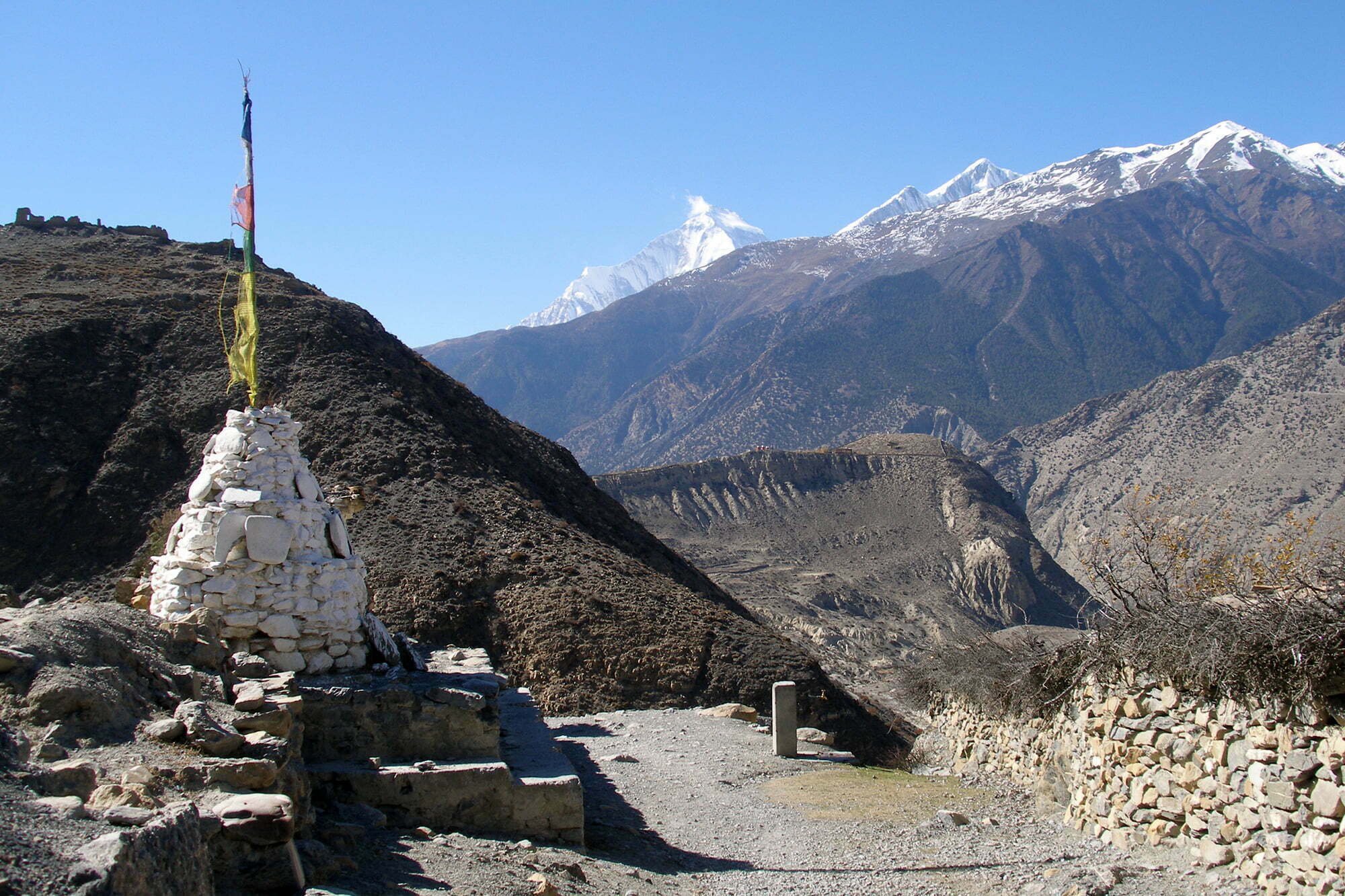 Jomsom
From Muktinath, the trail descends towards the Kali Gandaki Valley, passing through the village of Jharkot, back-dropped by sensational views of Dhaulagiri and Nilgiri (7061m). The terrain around Jharkot is a yellow, barren, almost moonlike landscape, dotted with patches of green cultivation, where man-made canals cut across the fields, irrigating the crops and fruit trees.
From here a short steep descent leads you to Eklebhatti on the floor of the Kali Gandaki Valley. Next, following the river down south, through the wide, windswept, and barren valley you will reach the ancient settlement of Jomsom
Maximum Altitude: 2760m
Duration: 4-5 hours
Meals: Breakfast, Lunch, and Dinner
Accommodation: Guesthouse
Jomsom
From Muktinath, the trail descends towards the Kali Gandaki Valley, passing through the village of Jharkot, back-dropped by sensational views of Dhaulagiri and Nilgiri (7061m). The terrain around Jharkot is a yellow, barren, almost moonlike landscape, dotted with patches of green cultivation, where man-made canals cut across the fields, irrigating the crops and fruit trees.
From here a short steep descent leads you to Eklebhatti on the floor of the Kali Gandaki Valley. Next, following the river down south, through the wide, windswept, and barren valley you will reach the ancient settlement of Jomsom
Maximum Altitude: 2760m
Duration: 4-5 hours
Meals: Breakfast, Lunch, and Dinner
Accommodation: Guesthouse 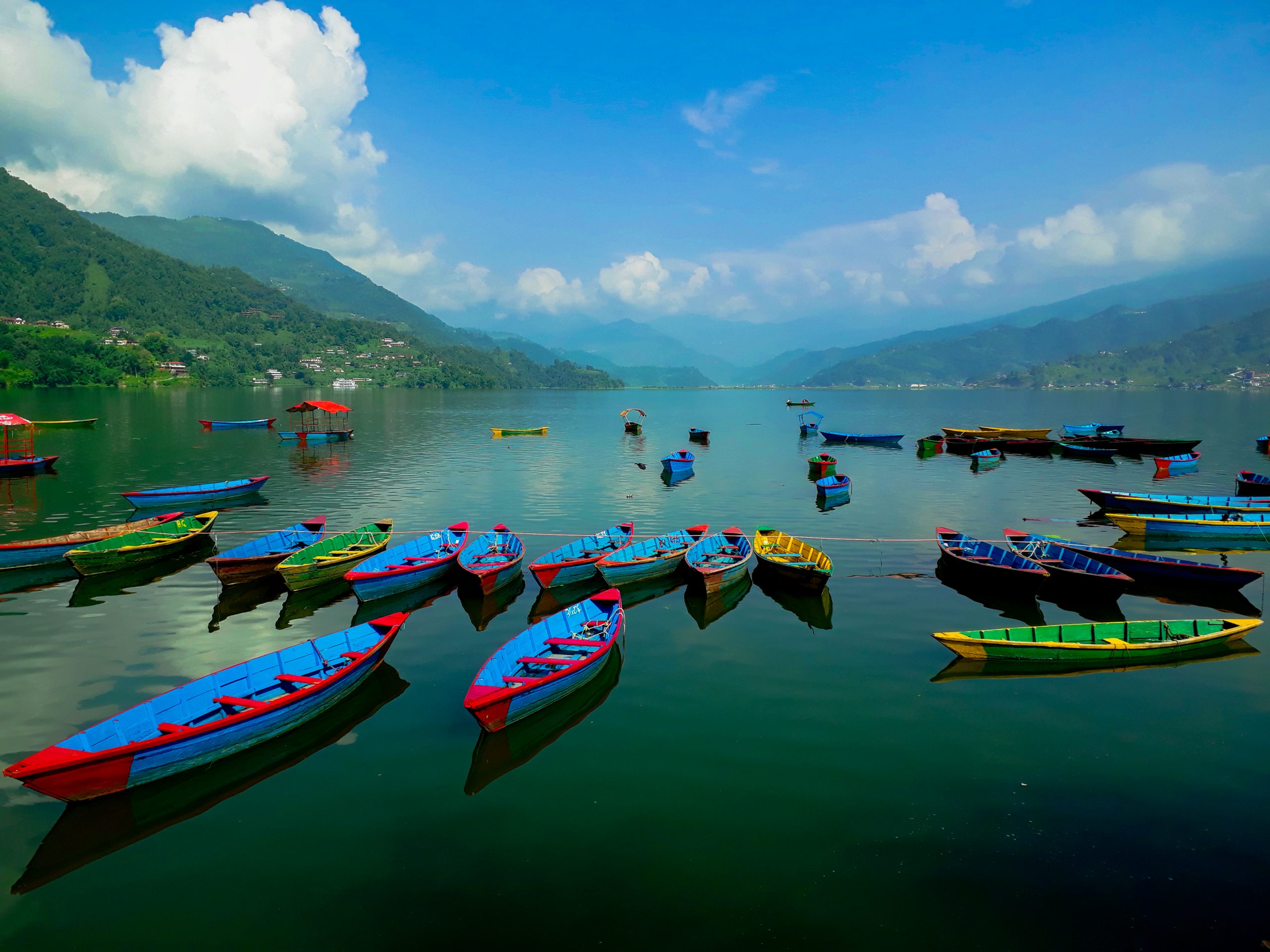 Pokhara: Phewa Lake
Today you will take an early morning flight from Jomsom to Pokhara which takes around 30 minutes. On the flight witness grand views of the landscapes flying parallel to the mountain ranges. Upon reaching Pokhara stroll around the city or head on a guided tour. Later visit various pubs and restaurants in the region.
Maximum Altitude: 822m
Duration: 30 minutes flight
Meals: Breakfast, Lunch, and Dinner
Accommodation: Hotel
Pokhara: Phewa Lake
Today you will take an early morning flight from Jomsom to Pokhara which takes around 30 minutes. On the flight witness grand views of the landscapes flying parallel to the mountain ranges. Upon reaching Pokhara stroll around the city or head on a guided tour. Later visit various pubs and restaurants in the region.
Maximum Altitude: 822m
Duration: 30 minutes flight
Meals: Breakfast, Lunch, and Dinner
Accommodation: Hotel 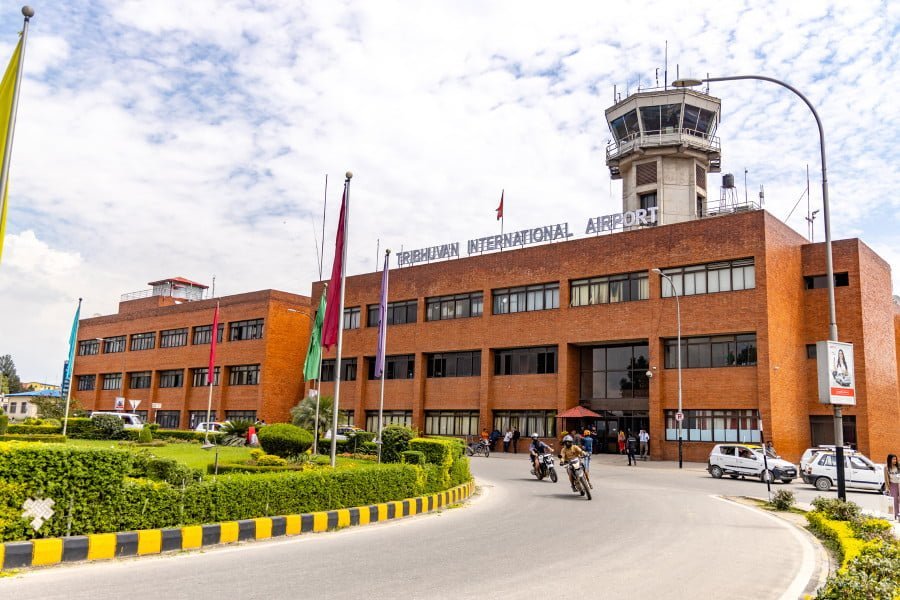 Kathmandu Tribhuwan International Airport(TIA)
Today you will be returning to your country. Alpine Club of Himalaya representative will drop you at the airport If you have any inquiries or require assistance and further information about this trip or any other trips, please feel free to contact Alpine Club of Himalaya – Walk of the Himalaya.
NOTE: All of the aforementioned trekking hours are approximations and should only be used as a general guideline.
Kathmandu Tribhuwan International Airport(TIA)
Today you will be returning to your country. Alpine Club of Himalaya representative will drop you at the airport If you have any inquiries or require assistance and further information about this trip or any other trips, please feel free to contact Alpine Club of Himalaya – Walk of the Himalaya.
NOTE: All of the aforementioned trekking hours are approximations and should only be used as a general guideline. 









